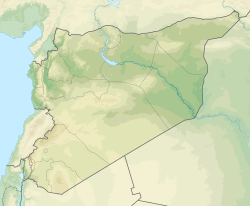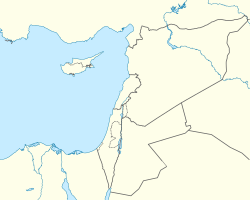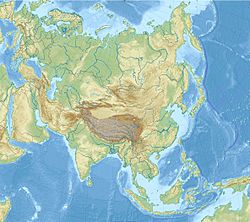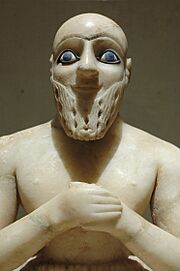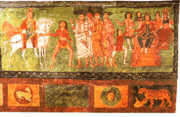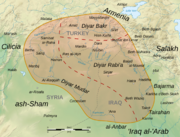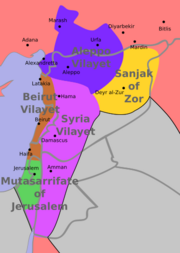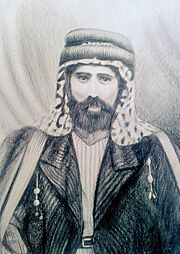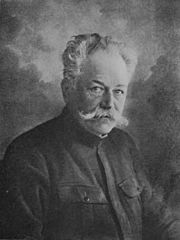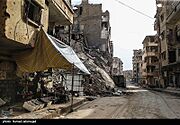Deir ez-Zor facts for kids
Quick facts for kids
Deir ez-Zor
دير الزور
ܕܝܪܐ ܙܥܘܪܬܐ |
|
|---|---|
|
City
|
|
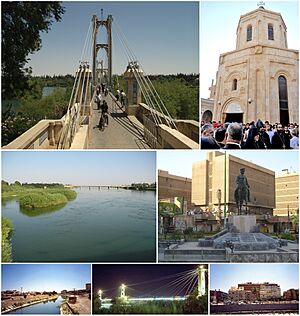
Suspension bridge • Memorial of Armenian genocide
Euphrates River • March 8 Square Panorama of Deir ez-Zor |
|
| Country | |
| Governorate | Deir ez-Zor Governorate |
| District | Deir ez-Zor District |
| Subdistrict | Deir ez-Zor Subdistrict |
| Date of establishment | 3000 BC (old Deir Ezzour) |
| Elevation | 210 m (690 ft) |
| Population
(2018 census)
|
|
| • Total | 271,800 |
| Demonym(s) | Deiri Arabic: ديري, romanized: Dayri |
| Time zone | UTC+2 (EET) |
| • Summer (DST) | UTC+3 (EEST) |
| Area code(s) | Country code: 963 City code: 051 |
| Geocode | C5086 |
| Climate | BWh |
| International airport | Deir ez-Zor Airport |
Deir ez-Zor (Arabic: دَيْرُ ٱلزَّوْرِ / دَيْرُ ٱلزُّور, romanized: Dayru z-Zawr / Dayru z-Zūr; Syriac: ܕܝܪܐ ܙܥܘܪܬܐ, romanized: Dayrāʾ Zəʿōrtāʾ) is a major city in eastern Syria. It is the seventh largest city in the country. You can find it on the banks of the Euphrates River, about 450 kilometers northeast of Damascus, the capital city. Deir ez-Zor is also the capital of the Deir ez-Zor Governorate. In 2018, about 271,800 people lived there.
Contents
- What Does the Name Deir ez-Zor Mean?
- A Look Back: The History of Deir ez-Zor
- What is the Economy Like in Deir ez-Zor?
- Culture and People
- International Connections
- What is the Climate Like?
- Images for kids
- See also
What Does the Name Deir ez-Zor Mean?
The city is often called Ad-Deir for short. In the Syriac language, Zeʿūrta means "little." So, Dīrā Zeʿūrta means "small habitation" or "small monastery."
The name Deir comes from an old word for "monastery." This suggests there was once a small Christian monastery here. These monasteries were common in Mesopotamia during early Christian times. The word Zor means "riverbank bush." This part of the name appeared later in Ottoman records.
You might see the city's name spelled in different ways. Some common spellings include Deir Ezzor, Deir Al-Zor, and Der Ezzor.
A Look Back: The History of Deir ez-Zor
How Old is Deir ez-Zor?
People have lived in the Deir ez-Zor area for a very long time. Archaeological findings show that people were here as far back as 9,000 BC! While the city's exact location wasn't always a huge population center, it was always part of an urban area. It was often connected to bigger, more powerful cities like the Kingdom of Mari, Syria, which grew strong around 3,000 BC.
Ancient Empires and Rulers
Around 3,000 BC, the Amorites settled here. They created the kingdom of Yamhad, and Deir ez-Zor was one of its towns. The city was small enough that it wasn't usually destroyed by large empires like the Akkadian Empire or Assyrian Empire. These empires sometimes destroyed bigger cities to prevent rebellions.
Later, in the 3rd century BC, Alexander the Great passed through this region. He built the city of Dura-Europos nearby. Even though Greek culture was important, the Aramaic language remained widely spoken. When Syria became part of the Roman Empire in 64 BC, Deir ez-Zor was a small village called Azdra. The Romans made it a regional center and built a strong military base there. In the 3rd century AD, Queen Zenobia of Palmyra ruled Deir ez-Zor as part of her independent kingdom within the Roman Empire.
The Muslim Conquest
After some important wars in the Arabian Peninsula, the first caliph, Abu Bakr, sent armies to the Levant. Later, Umar ibn Al-Khattab became caliph. He ordered his general, Abu Ubaidah ibn al-Jarrah, to continue conquering the region. They took many cities like Damascus and Homs.
The Byzantine Empire asked for help from Arab Christians in Mesopotamia. A large army gathered and besieged Homs. To help, Omar ibn al-Khattab sent forces from Iraq, led by Iyad ibn Ghanm. When the Byzantines heard about this new army, they left Homs. Iyad then invaded Upper Mesopotamia in 638 AD, and Deir ez-Zor was conquered.
At that time, many people in Deir ez-Zor were Christians or Jews. There was a Christian monastery that later became the Omari Mosque. Many Christians either left or converted to Islam.
During the Abbasid era, Deir ez-Zor grew. Farming became better because of new ways to water the land. The town, then called 'Deir Al-Rumman,' was later destroyed by the Mongols in the 13th century.
Deir ez-Zor Under Ottoman Rule (1517–1918)

The Ottoman Empire took control of Syria in 1517. Deir ez-Zor was a small town on the Euphrates River. The Ottomans used it as a center for their officials. They also encouraged tribal leaders to settle there to protect trade routes between Aleppo and Baghdad.
Travelers described Deir ez-Zor as a town with houses close together on a hill. Its people were strong and welcoming. They grew wheat, barley, cotton, and corn. They also had fruit orchards with palm trees, lemons, and oranges.
The city often faced attacks from Bedouin groups who wanted to steal goods. The Wahhabis attacked in 1807, and the city was looted many times. Because the Ottoman Empire was busy with wars, the people of Deir ez-Zor had to arm themselves. They formed a local army to defend the city. This helped reduce attacks, but the city also became smaller and more isolated. However, this isolation also made the people self-reliant. They started making many of their own tools and goods, like axes, swords, and gunpowder.
When things became safer, trade convoys started passing through again. Deir ez-Zor became a stop for them, offering food and rest. This helped the city reconnect with the outside world. Young people traveled to places like Hauran, Aleppo, and Baghdad for trade and work.
From 1831 to 1840, Ibrahim Pasha of Egypt ruled Deir ez-Zor. He made it part of Hama Sanjak. During his rule, many people in the city got rifles, which helped them defend against Bedouin attacks.
Zor Sanjak (1864–1918)
In 1864, Deir ez-Zor became the center of a new district called the Zor Sanjak. This district reported directly to the Grand Vizier in Istanbul, giving its ruler, the Mutasarrıf, a lot of power. The area of the Sanjak grew to include cities like Raqqa and Hasakah.
The rulers of Zor Sanjak improved security and planned the city better. They built schools, streets, and the first public park. They also built bridges over the Euphrates and some mosques. They encouraged planting trees and used boats for river crossings.
The Zor Sanjak lasted for 54 years, with 29 different rulers. The frequent changes in leadership and the lack of resources affected the city's growth. When World War I started in 1914, things got even harder. Many young men were forced to join the army, and there was famine and disease. Trade stopped, and farming declined.
After World War I
British Period (1919–1919)
After World War I, the British army occupied Deir ez-Zor on January 11, 1919. They made it part of Iraqi territory. The British focused on keeping the city safe and clean. They also opened a primary school where English was taught.
The people of Deir ez-Zor wanted to be free from British rule. They sent their wishes to the Arab government in Damascus. Iraqi officers in Damascus wanted to take Deir ez-Zor to use it as a base to free Iraq from British control. So, they sent Ramadan al-Shallash to be the governor of Raqqa. With the help of the local people, Ramadan al-Shallash occupied Deir ez-Zor. The British troops left on December 27, 1919.
French Mandate (1920–1946)
In July 1920, French General Henri Gouraud gave an ultimatum to the Syrian government. Even though the Syrian government accepted his demands, French troops marched towards Damascus. On July 24, 1920, the Battle of Maysalun ended with the Syrian army's defeat.
After taking control of Syria, France divided it into several smaller states. Deir ez-Zor, Raqqa, and Al-Hasakah became part of the State of Aleppo.
French forces entered Deir ez-Zor on November 9, 1921. Local leader Fadel Al-Aboud was arrested for protesting the occupation. He was later exiled for planning a revolt against the French. In June 1922, due to public pressure, the French created a Syrian federation.
Fighting for Freedom
Leaders of the Great Syrian Revolt contacted patriots in eastern Syria, like Mohammed Al-Ayyash. They wanted to spread the revolution to the Euphrates region to make the French forces spread out. Al-Ayyash gathered a group of thirteen armed men ready to fight the French.
Some Syrians working for the French secretly helped the revolutionaries. They gave Al-Ayyash information about French movements. In June 1925, Al-Ayyash learned that a military vehicle with four French officers was traveling from Deir ez-Zor to Aleppo. He told his brother Mahmoud to set up an ambush in Ain Albu Gomaa.
The revolutionaries attacked the vehicle, arrested the officers and their driver, and took their weapons. They then left them in an abandoned well, where they died.
The French were very angry. They launched a huge search, using planes. When they found the bodies, they attacked the Albu Saraya clan, bombing their villages. Houses were destroyed, and many civilians were killed or wounded. The French threatened to arrest the women of the revolutionaries if they didn't surrender. To protect their families, the revolutionaries gave themselves up.
The revolutionaries were tried in Aleppo. Mahmoud Al-Ayyash and 12 others were sentenced to death and executed on September 15, 1925. Mohammed Al-Ayyash was sentenced to 20 years in prison. Later, Ayyash Al-Haj was assassinated by poisoning in Jableh and buried there.
Syria Becomes Independent

During the first Syrian republic, Deir ez-Zor saw some progress. The famous suspension bridge was built, and the first bank, a palace of justice, a national library, and a city museum were established. Cultural clubs grew, electricity became available, and cafes became popular.
The city played a big part in the 1936 strike, which led to Syria signing an independence agreement with France. In 1941, Syria declared its independence. Mohammad Bey al-Ayesh from Deir ez-Zor became the first minister from the eastern province.
In 1941, British-led forces defeated the French in the Syria–Lebanon campaign, which included a battle over Deir ez-Zor. They handed control to the Free French.
After independence, Deir ez-Zor continued its political activity. In 1946, there was a "wheat uprising" against the governor because he was hoarding wheat. The people successfully fought for their rights.
In the 1950s, cotton farming became very popular, and new irrigation methods helped grow more crops. The discovery of oil and salt nearby also helped the city grow. More companies came, and people moved from the countryside to the city for work.
Recent Events (2011–Present)
Deir ez-Zor was one of the first cities to have large protests at the start of the Syrian civil war in March 2011. On April 15, 2011, a big protest happened, even with security forces using live bullets. On April 22, 2011, a statue of Basil al-Assad was pulled down.
In August 2011, Syrian security forces took control of the city. But in June 2012, the Free Syrian Army took control again.
ISIS Takes Over Part of the City
By early 2014, ISIS took over most of Deir ez-Zor. A small part of the city, including the airport, remained under the control of the Syrian Armed Forces. This area was under siege by ISIS for over two years. Supplies could only be delivered by helicopters. ISIS tried to stop these supplies by attacking the Deir ez-Zor Airport daily. However, the Syrian forces, led by Brigadier General Issam Zahreddine, held strong.
From April 2016 to August 2017, the World Food Programme dropped food and supplies into the besieged city using planes and parachutes. Over 8,000 pallets of aid were dropped in 309 flights.
In September 2017, the Syrian Army reached the city and joined the besieged forces, lifting the siege. By November 3, 2017, the Syrian Army had fully recaptured the city. They also secured the entire western bank of the Euphrates River by December 2017.
From September 2017 to March 2019, the Syrian Democratic Forces (SDF) and their allies fought against ISIS east of the Euphrates. This campaign ended with the SDF taking all ISIS territory in the Deir ez-Zor Governorate.
More recently, in December 2022, oil workers were killed by ISIS. In August 2023, there were fights between SDF fighters and local Arab tribes, leading to many deaths.
What is the Economy Like in Deir ez-Zor?
The area around Deir ez-Zor is very good for farming. People raise livestock, especially awassi sheep, and grow cereals and cotton. Many businesses related to farming are also in the city.
After light crude oil was found in the Syrian desert, Deir ez-Zor became important for the country's petroleum extraction industry. It's also a small center for tourism, with French-style restaurants along the river and hotels. It's a place where people stop when traveling across the desert. The city also has an airport (Deir ez-Zor Airport) and nearby salt mines.
Culture and People

Most people in Deir ez-Zor are Arab Sunni Muslims. There are also some Armenian and Assyrian/Syriac families.
Deir ez-Zor was a very sad place during the Armenian genocide. Many Armenians who were forced to leave their homes ended up here, and tens of thousands were killed along the Euphrates River. The Armenian Genocide Memorial Church was built to remember these victims, but it was destroyed by ISIS in 2014.
Over the years, many people from nearby rural areas moved to Deir ez-Zor, especially during times of drought. They often looked for jobs and changed from farming to city life. The type of Arabic spoken in the city is a Mesopotamian dialect, with a slight influence from the Aleppo dialect.
The city was also famous for the Deir ez-Zor suspension bridge, which crossed the Euphrates. Sadly, it was destroyed in 2013 during the civil war.
The Deir ez-Zor Museum holds thousands of ancient items found at nearby archaeological sites. The main campuses of Al-Furat University and Aljazeera University are in Deir ez-Zor. There are also many other schools for technical and professional training.
The local newspaper, Al Furat, is published here and distributed in nearby governorates like Al-Hasakah and Raqqa.
International Connections
Deir ez-Zor has an Honorary Consulate of Armenia, which opened in 2010. This is Armenia's third diplomatic office in Syria.
The Deir ez-Zor Airport is a small airport that connects the city with Damascus and places in the Persian Gulf region.
Sister City
 Armavir, Armenia, since October 2010.
Armavir, Armenia, since October 2010.
What is the Climate Like?
Deir ez-Zor has a hot desert climate. This means it is very hot and dry.
| Climate data for Deir Ez-Zor (1961–1990) | |||||||||||||
|---|---|---|---|---|---|---|---|---|---|---|---|---|---|
| Month | Jan | Feb | Mar | Apr | May | Jun | Jul | Aug | Sep | Oct | Nov | Dec | Year |
| Record high °C (°F) | 22.5 (72.5) |
26.1 (79.0) |
32.7 (90.9) |
40.0 (104.0) |
41.6 (106.9) |
44.2 (111.6) |
47.5 (117.5) |
47.8 (118.0) |
43.0 (109.4) |
41.0 (105.8) |
31.5 (88.7) |
23.0 (73.4) |
47.8 (118.0) |
| Mean daily maximum °C (°F) | 12.2 (54.0) |
15.1 (59.2) |
19.5 (67.1) |
25.4 (77.7) |
31.7 (89.1) |
36.9 (98.4) |
39.9 (103.8) |
39.3 (102.7) |
35.3 (95.5) |
28.8 (83.8) |
20.7 (69.3) |
14.0 (57.2) |
26.6 (79.9) |
| Daily mean °C (°F) | 6.7 (44.1) |
9.1 (48.4) |
13.1 (55.6) |
18.7 (65.7) |
24.5 (76.1) |
29.6 (85.3) |
32.6 (90.7) |
31.7 (89.1) |
26.9 (80.4) |
20.9 (69.6) |
13.3 (55.9) |
8.1 (46.6) |
19.6 (67.3) |
| Mean daily minimum °C (°F) | 2.5 (36.5) |
3.7 (38.7) |
7.0 (44.6) |
12.0 (53.6) |
17.1 (62.8) |
21.9 (71.4) |
25.1 (77.2) |
24.5 (76.1) |
19.4 (66.9) |
13.7 (56.7) |
7.2 (45.0) |
3.2 (37.8) |
13.1 (55.6) |
| Record low °C (°F) | −7.2 (19.0) |
−8.2 (17.2) |
−3.7 (25.3) |
−2.0 (28.4) |
8.0 (46.4) |
10.6 (51.1) |
17.6 (63.7) |
16.8 (62.2) |
11.4 (52.5) |
2.5 (36.5) |
−8.0 (17.6) |
−9.3 (15.3) |
−9.3 (15.3) |
| Average precipitation mm (inches) | 28.1 (1.11) |
24.1 (0.95) |
27.8 (1.09) |
22.2 (0.87) |
8.6 (0.34) |
0.3 (0.01) |
0.0 (0.0) |
0.0 (0.0) |
0.2 (0.01) |
8.0 (0.31) |
12.4 (0.49) |
24.1 (0.95) |
155.8 (6.13) |
| Average precipitation days (≥ 1.0 mm) | 4.8 | 4.3 | 4.3 | 3.5 | 1.7 | 0.1 | 0.0 | 0.0 | 0.1 | 1.5 | 2.6 | 4.1 | 27.0 |
| Average relative humidity (%) | 76 | 67 | 57 | 49 | 38 | 27 | 26 | 28 | 32 | 42 | 57 | 75 | 48 |
| Mean monthly sunshine hours | 161.2 | 179.2 | 223.2 | 243.0 | 310.0 | 351.0 | 372.0 | 356.5 | 309.0 | 257.3 | 207.0 | 161.2 | 3,130.6 |
| Mean daily sunshine hours | 5.2 | 6.4 | 7.2 | 8.1 | 10.0 | 11.7 | 12.0 | 11.5 | 10.3 | 8.3 | 6.9 | 5.2 | 8.6 |
| Source 1: Deutscher Wetterdienst | |||||||||||||
| Source 2: NOAA | |||||||||||||
Images for kids
-
A map showing the march of Khalid ibn al-Walid's army from Iraq to the Levant.
-
The extent of the Ottoman Empire in 1566, upon the death of Suleiman the Magnificent.
-
Ibrahim Pasha of Egypt, the ruler of Syria (1831–1840).
-
Former Deir ez-Zor suspension bridge crossing the Euphrates.
See also
 In Spanish: Deir ez-Zor (ciudad) para niños
In Spanish: Deir ez-Zor (ciudad) para niños


